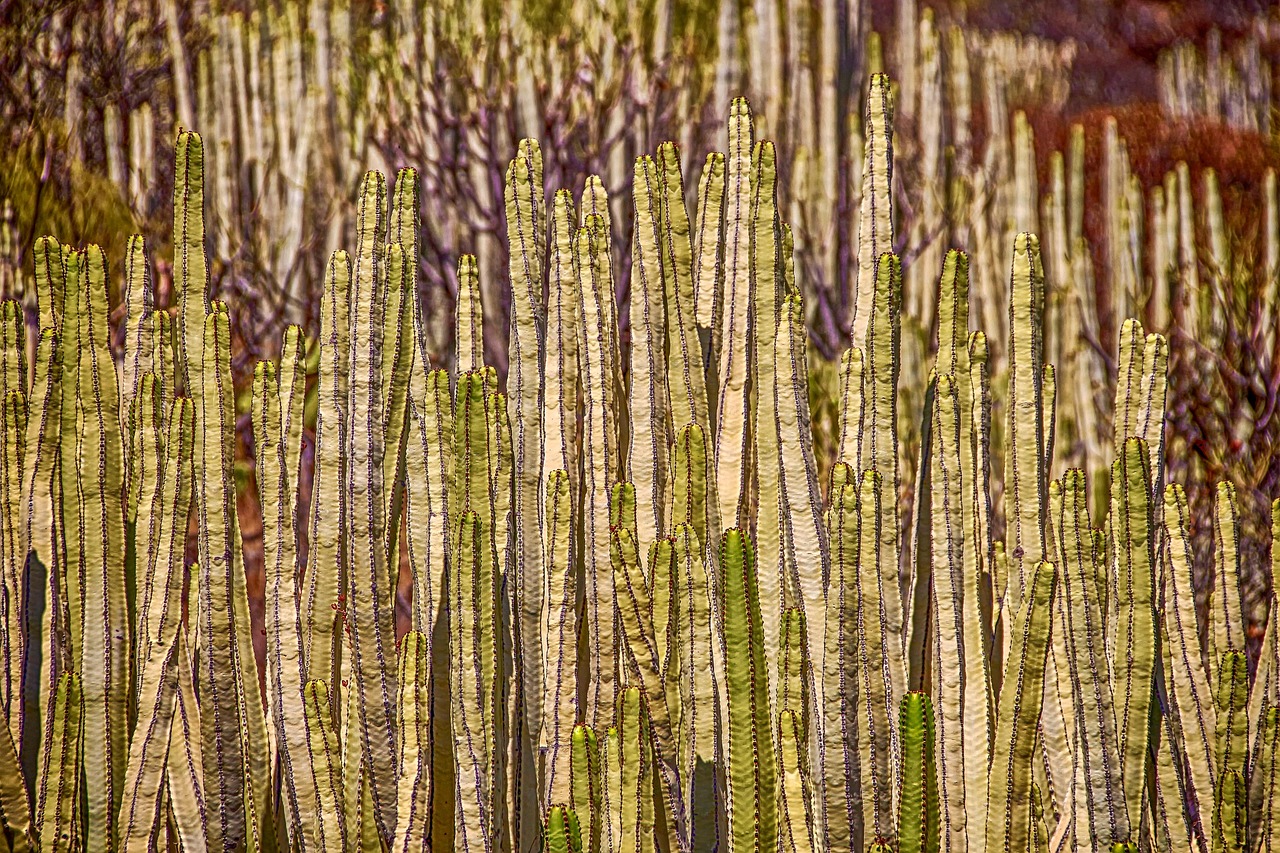April marks a vibrant time for cacti as they burst into bloom, showcasing their stunning flowers. This season offers a unique opportunity to witness the beauty and diversity of these remarkable plants. Let’s explore the enchanting world of cacti flowering in April.
Cacti are often recognized for their resilience in harsh environments. This adaptability allows them to thrive in arid conditions, where few other plants can survive. However, when spring arrives, many cacti reveal another side of their nature. The flowering process is not just a survival mechanism. It is a beautiful display of color and life that attracts pollinators and ensures the continuation of their species.

The blooming of cacti typically occurs during the warmer months, with April being one of the peak times for various species. The flowers can be strikingly beautiful, often featuring vibrant colors and intricate designs. Some blossoms can be quite large compared to the plant itself, creating a breathtaking visual contrast. Observing these blooms is a delightful experience for gardeners and nature enthusiasts alike.
Why Cacti Bloom in April
Several factors influence the timing of cactus blooms, particularly in April. Here are some key reasons:
- Temperature Changes: As temperatures rise in spring, cacti receive the necessary warmth to trigger blooming.
- Increased Daylight: Longer days provide additional light which stimulates growth and flowering.
- Water Availability: Spring rains often provide much-needed moisture, aiding in the blooming process.
Each of these factors plays a crucial role in the life cycle of cacti. Understanding these conditions helps enthusiasts appreciate the timing and beauty of cactus flowers.
Different species of cacti exhibit various blooming patterns and timelines. For example, some may bloom early in April, while others may wait until later in the month or even into May. The choice of blooming time can depend on local climate conditions and the specific needs of each species.
| Cactus Species | Blooming Period | Flower Color |
|---|---|---|
| Opuntia (Prickly Pear) | Early to Mid-April | Yellow, Pink, Red |
| Echinopsis | Mid-April | White, Pink, Purple |
| Mammillaria | Late April | White, Yellow |
| Ferocactus | April to May | Red, Orange, Yellow |
The table above lists some popular cactus species along with their blooming periods and flower colors. This diversity showcases the beauty and variety that cacti bring to gardens and natural landscapes during the spring season.
In addition to their visual appeal, the flowers of cacti often have unique adaptations for attracting specific pollinators. Many are designed to attract bees, hummingbirds, and bats, depending on the region. This relationship between cacti and their pollinators is vital for ecological balance and biodiversity.
Cacti require minimal maintenance, making them perfect for gardeners of all skill levels. With proper care, these plants can thrive and reward you with stunning blooms each spring. Understanding their growth patterns and environmental needs can enhance your gardening experience and increase the chances of witnessing their magnificent flowers in bloom.
Popular Cacti to Watch for in April
April is a fantastic month to observe a variety of cacti blooming. Each species displays its unique beauty, and some are particularly noteworthy for their captivating flowers. Here is a list of popular cacti that you can expect to see in bloom during this month:
- Opuntia (Prickly Pear): Known for its flat pads and vibrant flowers, Opuntia often blooms in shades of yellow, red, and pink.
- Echinopsis: This genus features large, showy flowers that can open overnight. Their blooms are typically white, pink, or purple.
- Mammillaria: A small and charming cactus, Mammillaria produces clusters of delicate flowers that are usually white or yellow.
- Ferocactus: Recognized for its striking spines, Ferocactus blooms in bright colors such as red, orange, and yellow, attracting attention in any garden.
The Unique Features of Cacti Flowers
Cacti flowers are not only beautiful but also exhibit several unique features that set them apart from other flowering plants. Understanding these characteristics can enhance your appreciation of their blooms.
- Short Lifespan: Many cactus flowers have a brief blooming period, often lasting only a day or two. This ephemerality adds to their allure.
- Night-Blooming Varieties: Some cacti, like certain Echinopsis species, bloom at night, attracting nocturnal pollinators like moths.
- Size Diversity: The size of cactus flowers can vary greatly. Some are small and delicate, while others can be quite large, sometimes measuring several inches across.
- Fragrance: Many cacti emit delightful scents during their blooming period, which can attract various pollinators.
Caring for Cacti During Blooming Season

To ensure that your cacti thrive during the blooming season, proper care is essential. Here are some tips to help you maintain healthy cacti and encourage beautiful blooms:
- Watering: During blooming, cacti require more water than usual. Water them deeply but allow the soil to dry out completely before the next watering.
- Light Requirements: Place your cacti in a location where they receive plenty of sunlight. Most cacti thrive in bright, indirect light.
- Fertilization: Use a balanced fertilizer specifically designed for cacti during the growing season to promote healthy blooms.
- Pest Control: Monitor your cacti for pests such as spider mites or mealybugs. Use organic insecticidal soap if needed to keep them healthy.
By following these care tips, you can help ensure that your cacti not only survive but also flourish during the blooming season. Observing their growth and blooms can be a rewarding experience for any gardener.
The Role of Pollinators in Cactus Blooming
Pollinators play a crucial role in the reproduction of cacti. Many cacti have developed specific adaptations to attract these important creatures. Here are some common pollinators associated with cactus flowers:
- Bees: Many species of bees are attracted to cactus flowers due to their bright colors and sweet nectar.
- Hummingbirds: These birds are particularly drawn to red and tubular flowers, making them excellent pollinators for many cacti.
- Bats: In desert regions, bats are vital for night-blooming cacti as they feed on nectar during nighttime hours.
The relationship between cacti and their pollinators is a fascinating aspect of ecology. By attracting specific pollinators, cacti ensure their survival and propagation while contributing to the local ecosystem’s health.

Exploring the Different Types of Cacti Flowers

Cacti are renowned for their remarkable flowers, which come in a dazzling array of shapes, sizes, and colors. Understanding the different types of cactus flowers can enhance your appreciation for these resilient plants. Below are some popular flower types found in various cactus species:
- Classic Cup-Shaped Flowers: Many cacti, such as the Echinopsis, produce cup-shaped flowers that open wide to reveal their colorful inner petals. These flowers often attract bees and butterflies.
- Tubular Flowers: Species like the trumpet cactus (Echinopsis) have long, tubular flowers that are ideal for hummingbirds, allowing them easy access to nectar.
- Clustered Flowers: Some cacti, like Mammillaria, produce multiple small blooms clustered together, creating a stunning display. These flowers can be white, pink, or yellow.
- Columnar Flowers: Columnar cacti such as the Saguaro often have flowers that grow along the length of the cactus, adding a unique vertical element to their appearance.
The Colors of Cactus Flowers
The color of cactus flowers can be as diverse as their shapes. Flower colors serve various purposes, especially in attracting pollinators. Here are some common colors and their implications:
- Red: Often associated with hummingbird pollination, red flowers are striking and vibrant.
- Yellow: Bright yellow flowers attract bees and other insects, signaling a rich source of nectar.
- Pink and Purple: These colors can appeal to a variety of pollinators and are often seen in popular species like Echinopsis.
- White: Typically found in night-blooming species, white flowers are designed to attract nocturnal pollinators like bats.
The Importance of Soil for Cacti Blooming
The right soil is vital for the health and blooming of cacti. Unlike many other plants, cacti thrive in well-draining soil that mimics their natural desert habitats. Here are some key factors to consider when selecting soil for your cacti:
- Drainage: Cacti require soil that allows excess water to escape. A mix that includes sand or perlite can enhance drainage.
- Nutrient Content: While cacti are low-maintenance, they still benefit from nutrient-rich soil during the growing season. Look for mixes specifically designed for succulents and cacti.
- pH Level: Most cacti prefer slightly acidic to neutral soil (pH 6.0 to 7.0). Testing your soil’s pH can help you make necessary adjustments.
Creating or purchasing the right soil mix is essential for promoting healthy growth and vibrant blooms. Many gardeners find that a blend of regular potting soil with additional sand or gravel works well for cacti.
Watering Practices During Blooming Season
Watering practices vary during the blooming season compared to other times of the year. Proper watering ensures that cacti receive the hydration they need without becoming waterlogged. Here are some guidelines:
- Frequency: Increase watering frequency during blooming, but ensure the soil dries out completely between waterings.
- Water Temperature: Use room-temperature water to avoid shocking the plant.
- Observe Your Cactus: Look for signs of dehydration such as shriveling or discoloration, which may indicate a need for more water.
By adjusting your watering practices during the blooming season, you can support your cacti in producing magnificent flowers while keeping them healthy and thriving.
Common Cactus Diseases and Pests
While cacti are generally hardy plants, they can still fall victim to diseases and pests, especially during the blooming season when they are most vulnerable. Recognizing and addressing these issues promptly can save your plants and enhance their blooming potential. Here are some common problems to watch for:
- Root Rot: Caused by overwatering, root rot can lead to wilting and yellowing of the cactus. Ensure proper drainage to prevent this condition.
- Mealybugs: These pests appear as white cottony spots on the cactus. They can be removed with insecticidal soap or by manually wiping them off.
- Spider Mites: Often found on the undersides of cactus pads, spider mites can cause stippling and discoloration. Increasing humidity can help deter them.
- Pythium Blight: This fungal infection leads to soft, mushy areas on the cactus. Treat it with appropriate fungicides and improve air circulation around your plants.
Regular inspection of your cacti can help you catch these issues early. Taking preventive measures, such as ensuring adequate air circulation and avoiding overcrowding, can also contribute to the health of your cacti.
Creating a Stunning Cactus Display
For those looking to showcase their blooming cacti, creating an eye-catching display can elevate any garden or indoor space. Here are some tips to design a beautiful cactus arrangement:
- Diverse Species: Incorporate a variety of cactus species with different shapes, sizes, and blooming periods for visual interest.
- Color Coordination: Choose cacti with complementary flower colors to create a cohesive look. Pairing vibrant blooms with contrasting foliage adds depth.
- Layering: Use height variation to create layers in your display. Taller cacti can serve as focal points, while shorter ones can fill in gaps.
- Container Choice: Select attractive pots that complement your cactus color scheme. Terracotta pots are classic choices that allow for excellent drainage.
By thoughtfully arranging your cacti, you can create a stunning display that highlights their unique beauty during the blooming season.
Final Thoughts
Cacti offer a remarkable spectacle when they bloom in April, showcasing their resilience and adaptability through vibrant colors and unique shapes. As you cultivate these stunning plants, understanding their needs, from proper care to the importance of pollinators, will enhance both your gardening experience and your appreciation for nature’s wonders.
Whether you’re a seasoned gardener or a curious beginner, witnessing cactus blooms is a gratifying experience that connects you to the rhythms of nature. By following the tips outlined in this article—such as understanding watering practices, recognizing pests, and designing beautiful displays—you can enjoy a flourishing cactus garden filled with life and color each spring.
As you embark on this journey of growing cacti, remember that each bloom is not just a celebration of beauty but also a testament to the resilience of life in challenging environments. Embrace the joy that comes from nurturing these remarkable plants and watch as they transform your space with their stunning floral displays.
